Palit GeForce GTX 680 Jetstream 2 GB and GeForce GTX 680 SLI Review

Today we will talk about the design and functionality of the proprietary GeForce GTX 680 graphics cards. We will test two graphics cards like that in an SLI configuration, compare it against a dual-processor GeForce GTX 690 and other products.
The shortage of GK104 Kepler chips seems to have been dealt with and new GeForce GTX 680s are available aplenty from retailers. Besides copies of the reference card selling under different brands, we can also see original versions which were announced along with the GeForce GTX 680 but were actually released a few weeks later. One of them is the highly exciting Palit GeForce GTX 680 Jetstream 2 GB we are going to examine today. Moreover, we will benchmark two GeForce GTX 680s in SLI mode and compare this set-up with the world’s fastest graphics card GeForce GTX 690.
Closer Look at Palit GeForce GTX 680 Jetstream 2 GB (NE5X680H1042-1040J)
Technical Specifications and Recommended Pricing
The Palit GeForce GTX 680 Jetstream specs are listed in the table in comparison with the GeForce GTX 680, the discrepancies formatted in bold font:
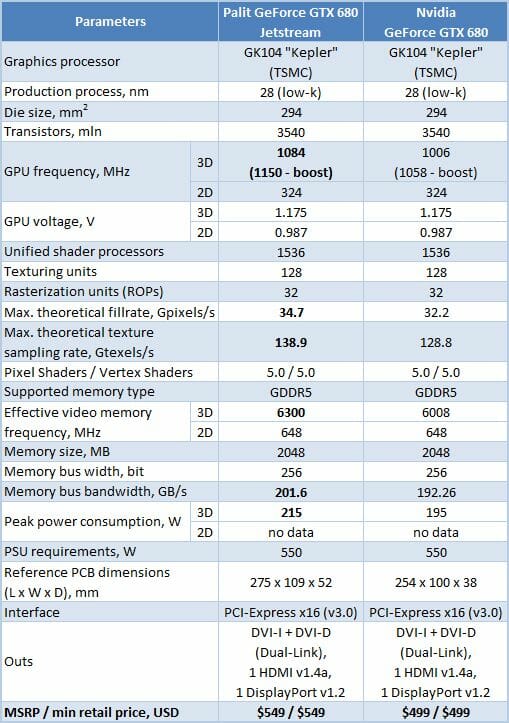
Palit also offers a GeForce GTX 680 Jetstream with clock rates of 1006/6008 MHz and as much as 4 gigabytes of onboard memory for $640, but we haven’t been able to get a sample to test.
Packaging and Accessories
The box with Palit GeForce GTX 680 Jetstream is large and has a lot of information on its back:
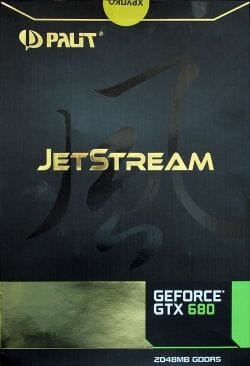
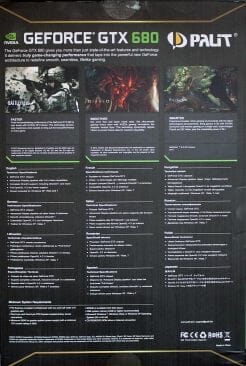
If that’s not enough, you can open the front of the box up and read detailed information about each component of the new graphics card and even see the latter through a plastic window.
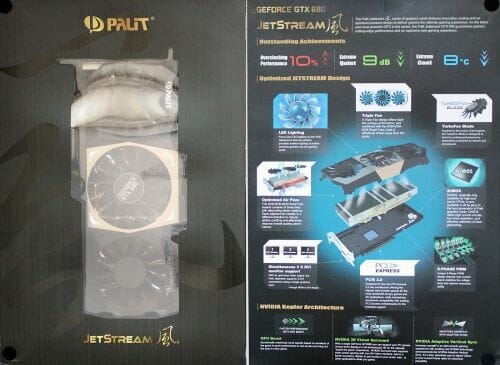
According to that information, the Palit GeForce GTX 680 Jetstream is expected to have 10% higher overclocking potential, 9 dB lower noise and 8°C lower temperature compared to the reference sample.
The accessories are rather meager. The card is accompanied by two adapters, a power cable, a CD with drivers and a brief installation guide.
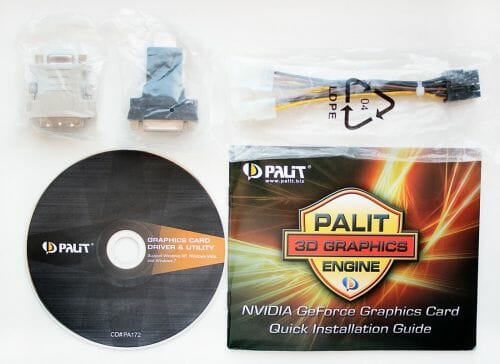
There are no interface cables or video games or any other extras in the box, although this is a premium-class product with a recommended price of $549. We guess that buyers of this graphics card would appreciate a fuller set of accessories.
The Palit GeForce GTX 680 Jetstream is manufactured in China. Its warranty period is 1 year.
Design and Features
The Palit GeForce GTX 680 Jetstream looks attractive and completely different from the reference GeForce GTX 680. Its entire face side is covered by the plastic casing of the cooling system with three pretty fans.
The casing is painted in such a way that it seems to be made of three separate parts, although it’s actually monolithic. The manufacturer and product names can be seen on the edge of the casing. The Palit GeForce GTX 680 Jetstream measures 275x109x52 millimeters, which is slightly larger than the reference GeForce GTX 680.
Like the reference sample, the Palit version has two dual-link DVI ports, one HDMI 1.4a, and one DisplayPort version 1.2:
There’s a vent grid in the card’s mounting bracket to exhaust the hot air out of the system case. Some of the air will remain inside, however, being exhausted at the opposite side of the card.
Instead of two 6-pin power connectors of the reference GeForce GTX 680, the Palit version is equipped with one 8-pin and one 6-pin connector which are indicative of a more advanced power system.
The card has two MIO connectors for SLI configurations. The Palit GeForce GTX 680 Jetstream has a custom PCB.Instead of the reference 4+2 power system, it employs a 6+2 system with DrMOS transistors.Considering the reinforced power system and increased power draw (up to 215 watts), Palit promises 10% higher overclocking potential and better stability for this graphics card.
Manufactured in Taiwan on 28nm tech process, the GPU is revision A2 and dated the sixth week of 2012 (early February).
The GPU has the standard GK104 Kepler configuration but its base frequency in 3D mode is pre-overclocked from 1006 to 1085 MHz while the boost frequency is as high as 1150 MHz (1163 MHz according to our monitoring tools). The GPU voltage isn’t higher than that of the reference GeForce GTX 680 at 1.175 volts. The frequency and voltage of the GPU are lowered to 324 MHz and 0.987 volts, respectively, in 2D mode.
The Palit GeForce GTX 680 Jetstream employs the same memory chips as the reference card: H5GQ2H24MFR R0C from Hynix Semiconductor.
The memory is pre-overclocked from 6008 to 6300 MHz (by 5%) in 3D mode. This is not much of overclocking, especially as memory clock rate doesn’t influence the performance of a GeForce GTX 680 much. The memory bus being 256 bits wide, the bandwidth is as high as 201.6 GB/s. The memory clock rate is dropped to 648 MHz in 2D mode.
Here is a summary of the Palit GeForce GTX 680 Jetstream specs:
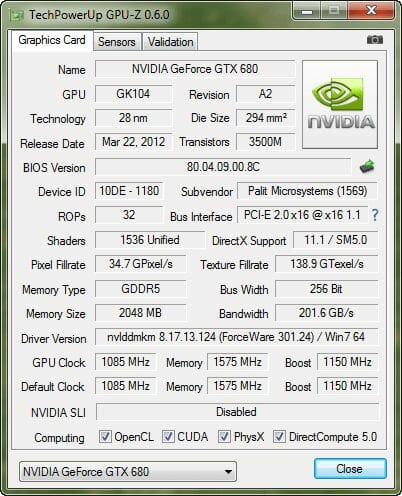
Cooling System: Efficiency and Noise
Besides the reinforced power system and pre-overclocked GPU and memory, the Palit GeForce GTX 680 Jetstream features an original cooler which has a large aluminum heatsink with four copper heat pipes.
Three of the pipes are 6 millimeters in diameter whereas the fourth pipe, which is separate from the others and serves the back part of the heatsink, is 8 millimeters. The pipes are soldered to the heatsink fins as well as to the nickel-plated copper base of the cooler.
There’s a layer of thick gray thermal grease on the GPU die.The power components and memory chips are cooled by means of a metallic plate with thermal pads.The cooler has three fans installed in the plastic frame.
The central fan is 90 millimeters in diameter whereas the other two are 80 millimeters. The fans are all manufactured by Power Logic Tech and run on fluid dynamic bearings.
The speed of the fans is PWM-regulated within a range of 900 to 2700 RPM. The 90mm fan in the middle features blue highlighting.
We checked out the card’s temperature while running Aliens vs. Predator (2010) in five cycles at the highest settings (2560×1600, with 16x anisotropic filtering and 4x antialiasing).
We used MSI Afterburner 2.2.0 and GPU-Z 0.6.2 as monitoring tools. This test was carried out with a closed system case at an ambient temperature of 23°C. We didn’t change the card’s default thermal interface.
Let’s see what temperature the card has when its fans are regulated automatically and at the maximum speed of the fans.
So, in the automatic regulation mode the GPU temperature was 78°C, which isn’t much for a pre-overclocked GTX 680. Considering that the peak speed of the fans was only 1720 RPM, the result is just excellent. We can remind you that the reference GeForce GTX 680 at the default clock rates and under the same conditions gets as hot as 81°C and has a fan speed of 2460 RPM. So again, the Palit’s result is impressive indeed. When the fans were set at their maximum speed of 2610 RPM, the GPU of the Palit card was no hotter than 64°C.
Then we measured the level of noise using an electronic noise-level meter CENTER-321 in a closed and quiet room about 20 sq. meters large. The noise-level meter was set on a tripod at a distance of 15 centimeters from the graphics card which was installed on an open testbed. The mainboard with the graphics card was placed at an edge of a desk on a foam-rubber tray.
The bottom limit of our noise-level meter is 29.8 dBA whereas the subjectively comfortable (not low, but comfortable) level of noise when measured from that distance is about 36 dBA. The speed of the graphics card’s fan was being adjusted by means of a controller that changed the supply voltage in steps of 0.5 V.
We’ve included the results of reference GeForce GTX 680 and Radeon HD 7970 cards into the next diagram for the comparison’s sake (the vertical dotted lines indicate the top speed of the fans in automatic regulation mode).
The picture is more complicated here. The noise graph of the Palit GeForce GTX 680 Jetstream goes higher than the graphs of the reference GeForce GTX 680 and Radeon HD 7970. But if we compare the coolers in the automatic fan regulation mode, we can see that the Palit is no louder than the reference GTX 680 (51 against 52 dBA) and much better than the Radeon HD 7970 (51 against 59 dBA). So, the Palit GeForce GTX 680 Jetstream is actually quieter than the two reference card in 3D applications, but we have to confess that it’s louder than its opponents in 2D mode and is even louder than the subjectively comfortable level. In other words, the Palit’s cooler is audible against the background noise of the quiet system case in 2D mode. That’s a serious downside in our opinion. Hopefully, Palit will release a BIOS update with a lower fan setting for 2D applications.
Overclocking Potential
Although the Palit GeForce GTX 680 Jetstream is pre-overclocked back at the factory, we managed to slightly increase the GPU frequency of our sample and also get a substantial increase in its memory frequency. The GPU was stable at a base clock rate of 1155 MHz (and a boost clock rate of 1233 MHz). The graphics memory could work at 6900 MHz.
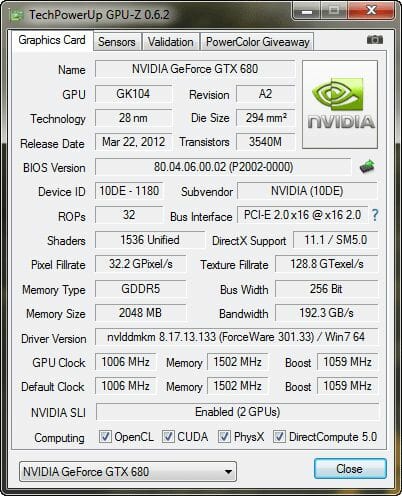
The most interesting thing is that the temperature of our Palit remained at the same level, 78°C, under peak load at the same speed of the fans!
Palit’s cooler is highly efficient indeed.
Testbed Configuration and Testing Methodology
All graphics cards were tested in a system with the following configuration:
- Mainboard: Intel Siler DX79SI (Intel X79 Express, LGA 2011, BIOS 0460 from 03/27/2012);
- CPU: Intel Core i7-3960X Extreme Edition, 3.3 GHz, 1.2 V, 6 x 256 KB L2, 15 MB L3 (Sandy Bridge-E, C1, 32 nm);
- CPU cooler: Phanteks PH-TC14PE (2 x 135 mm fans at 900 RPM);
- Thermal interface: ARCTIC MX-4;
- System memory: DDR3 4 x 4GB Mushkin Redline (Spec: 2133 MHz / 9-11-10-28 / 1.65 V);
- Graphics cards:
- Nvidia GeForce GTX 690 2 x 2 GB, 256 bit, GDDR5, 915/6008 MHz;
- Palit GeForce GTX 680 Jetstream 2 GB, 256 bit, GDDR5, 1006/6300 MHz;
- NVIDIA GeForce GTX 680 2 GB/256 bit GDDR5, 1006/6008 MHz;
- Gigabyte Radeon HD 7970 Ultra Durable 3 GB/384 bit GDDR5, 1000/5800 MHz;
- Sapphire Radeon HD 7970 OC Dual-X 3 GB/384 bit GDDR5, 1000/5800 MHz;
- System drive: Crucial m4 256 GB SSD (SATA-III,CT256M4SSD2, BIOS v0009);
- Drive for programs and games: Western Digital VelociRaptor (300GB, SATA-II, 10000 RPM, 16MB cache, NCQ) inside Scythe Quiet Drive 3.5” HDD silencer and cooler;
- Backup drive: Samsung Ecogreen F4 HD204UI (SATA-II, 2 TB, 5400 RPM, 32 MB, NCQ);
- System case: Antec Twelve Hundred (front panel: three Noiseblocker NB-Multiframe S-Series MF12-S2 fans at 1020 RPM; back panel: two Noiseblocker NB-BlackSilentPRO PL-1 fans at 1020 RPM; top panel: standard 200 mm fan at 400 RPM);
- Control and monitoring panel: Zalman ZM-MFC3;
- Power supply: Xigmatek “No Rules Power” NRP-HC1501 1500 W (with a default 140 mm fan);
- Monitor: 30” Samsung 305T Plus.
The frequencies of GeForce GTX 680 graphics cards tested in SLI configuration were adjuted to the nominal values:
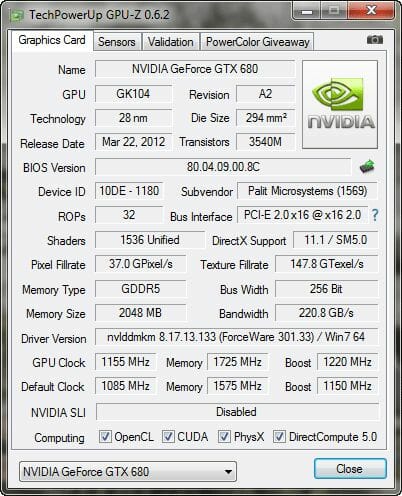
In order to lower the dependence of the graphics cards performance on the overall platform speed, I overclocked our 32 nm six-core CPU with the multiplier set at 37x, BCLK frequency set at 125 MHz and “Load-Line Calibration” enabled to 4.625 GHz. The processor Vcore was increased to 1.46 V in the mainboard BIOS.
Hyper-Threading technology was enabled. 16 GB of system DDR3 memory worked at 2 GHz frequency with 9-11-10-28 timings and 1.65V voltage.
The test session started on May 1, 2012. All tests were performed in Microsoft Windows 7 Ultimate x64 SP1 with all critical updates as of that date and the following drivers:
- Intel Chipset Drivers 9.3.0.1020 WHQL from 01/26/2011 for the mainboard chipset;
- DirectX End-User Runtimes libraries from November 30, 2010;
- AMD Catalyst 12.3 driver from 03/28/2012 + Catalyst Application Profiles 12.3 (CAP1) from 03/29/2012 for AMD based graphics cards;
- Nvidia GeForce 301.33 beta driver for Nvidia graphics cards.
The graphics cards were tested in two resolutions: 1920×1080 and 2560×1600. The tests were performed in two image quality modes: “Quality+AF16x” – default texturing quality in the drivers with enabled 16x anisotropic filtering and “Quality+ AF16x+MSAA 4(8)x” with enabled 16x anisotropic filtering and full screen 4x or 8x antialiasing if the average framerate was high enough for comfortable gaming experience. We enabled anisotropic filtering and full-screen anti-aliasing from the game settings. If the corresponding options were missing, we changed these settings in the Control Panels of Catalyst and GeForce drivers. We also disabled Vsync there. There were no other changes in the driver settings.
The list of games and applications used in this test session includes two popular semi-synthetic benchmarking suites, one technical demo and 15 games of various genres:
- 3DMark Vantage (DirectX 10) – version 1.0.2.1, Performance and Extreme profiles (only basic tests);
- 3DMark 2011 (DirectX 11) – version 1.0.3.0, Performance and Extreme profiles;
- Unigine Heaven Demo (DirectX 11) – version 3.0, maximum graphics quality settings, tessellation at “extreme”, AF16x, 1280×1024 resolution with MSAA and 1920×1080 with MSAA 8x;
- S.T.A.L.K.E.R.: Call of Pripyat (DirectX 11) – version 1.6.02, Enhanced Dynamic DX11 Lighting profile with all parameters manually set at their maximums, we used our custom cop03 demo on the Backwater map;
- Left 4 Dead 2 (DirectX 9) – version 2.1.0.0, maximum graphics quality settings, proprietary d98 demo (two runs) on “Death Toll” map of the “Church” level;
- Metro 2033: The Last Refuge (DirectX 10/11) – version 1.2, maximum graphics quality settings, official benchmark, “High” image quality settings; tesselation, DOF and MSAA4x disabled; AAA aliasing enabled, two consecutive runs of the “Frontline” scene;
- Just Cause 2 (DirectX 11) – version 1.0.0.2, maximum quality settings, Background Blur and GPU Water Simulation disabled, two consecutive runs of the “Dark Tower” demo;
- Aliens vs. Predator (2010) (DirectX 11) – Texture Quality “Very High”, Shadow Quality “High”, SSAO On, two test runs in each resolution;
- Lost Planet 2 (DirectX 11) – version 1.0, maximum graphics quality settings, motion blur enabled, performance test “B” (average in all three scenes);
- StarCraft 2: Wings of Liberty (DirectX 9) – version 1.4.3, all image quality settings at “Extreme”, Physics at “Ultra”, reflections On, two 2-minute runs of our own “bench2” demo;
- Sid Meier’s Civilization V (DirectX 11) – version 1.0.1.348, maximum graphics quality settings, two runs of the “diplomatic” benchmark including five heaviest scenes;
- Tom Clancy’s H.A.W.X. 2 (DirectX 11) – version 1.04, maximum graphics quality settings, shadows On, tessellation Off (not available on Radeon), two runs of the test scene;
- Total War: Shogun 2 (DirectX 11) – version 2.0, built in benchmark (Sekigahara battle) at maximum graphics quality settings;
- Crysis 2 (DirectX 11) – version 1.9, we used Adrenaline Crysis 2 Benchmark Tool v.1.0.1.13. BETA with “Ultra High” graphics quality profile and activated HD textures, two runs of a demo recorded on “Times Square” level;
- DiRT 3 (DirectX 11) – version 1.2, built-in benchmark at maximum graphics quality settings on the “Aspen” track;
- Hard Reset Demo (DirectX 9) – benchmark built into the demo version with Ultra image quality settings, one test run;
- Batman: Arkham City (DirectX 11) – version 1.2, maximum graphics quality settings, physics disabled, two sequential runs of the benchmark built into the game.
- Battlefield 3 (DirectX 11) – version 1.3, all image quality settings set to “Ultra”, two successive runs of a scripted scene from the beginning of the “Going Hunting” mission 110 seconds long.
If the game allowed recording the minimal fps readings, they were also added to the charts. We ran each game test or benchmark twice and took the best result for the diagrams, but only if the difference between them didn’t exceed 1%. If it did exceed 1%, we ran the tests at least one more time to achieve repeatability of results.
Performance
3DMark Vantage
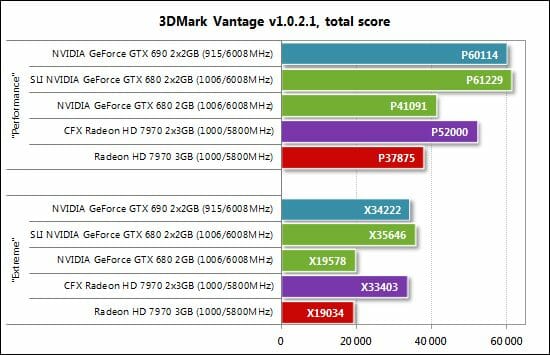
As expected, the GeForce GTX 680 SLI configuration is the fastest solution according to 3DMark Vantage, beating the dual-GPU GeForce GTX 690 by 2-4%. The efficiency of the SLI technology depends on load: the two GeForce GTX 680s are only 49% ahead of the single such card at the Performance settings but enjoy an 82% advantage at the Extreme settings. The GTX 680 SLI is also 7 to 18% ahead of the overclocked tandem of Radeon HD 7970s.
3DMark 2011
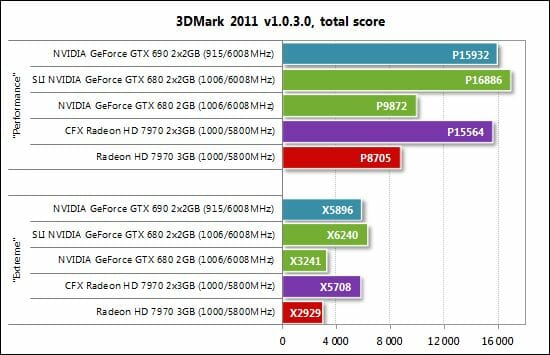
3DMark 2011 agrees with its predecessor but the SLI tandem is even more efficient here, outperforming the single GTX 680 by 71-93% and the dual-chip GeForce GTX 690, by 6%.
Unigine Heaven Demo
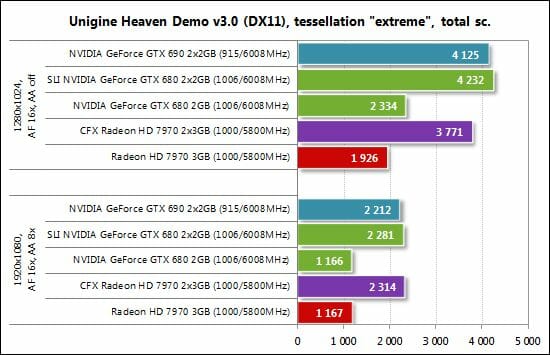
Although SLI is just as efficient here as in 3DMark, the SLI tandem is only 2-3% ahead of the GeForce GTX 690. The Radeon HD CrossFireX configuration clocked at 1000/5800 MHz is very close, too, and even beats its opponents when we enable antialiasing.
S.T.A.L.K.E.R.: Call of Pripyat
This game produces interesting results:
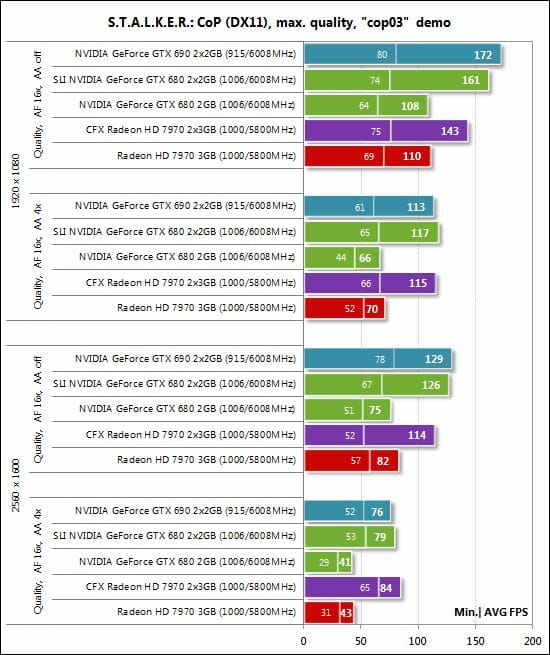
The pair of GeForce GTX 680s isn’t much better than the dual-chip GeForce GTX 690 despite the latter’s lower clock rates. Take note that the bottom frame rate of the GTX 690 is often higher than that of the SLI tandem. It’s also interesting that the Radeon HD 7970 CrossFireX overtakes the GeForce GTX 680 SLI at higher loads when the game needs more and faster graphics memory.
Left 4 Dead 2
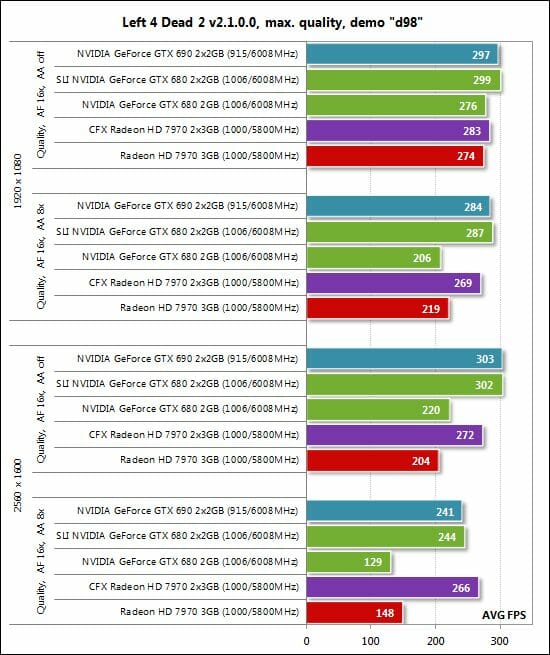
Our platform isn’t fast enough for the tested solutions to show their best in Left 4 Dead 2. It is only at 2560×1600 with 8x MSAA that the graphics cards differ, the Radeons being slightly ahead of their opponents (thanks to the increased clock rates).
Metro 2033: The Last Refuge
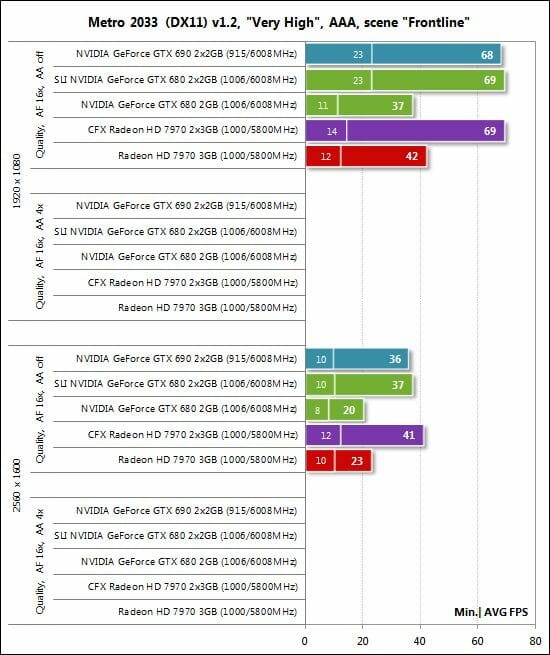
The GeForce GTX 690, GeForce GTX 680 SLI and Radeon HD 7970 CrossFireX are almost equal in this test. They are all equally slow at 2560×1600, however odd this statement may sound in reference to such expensive graphics hardware.
Just Cause 2
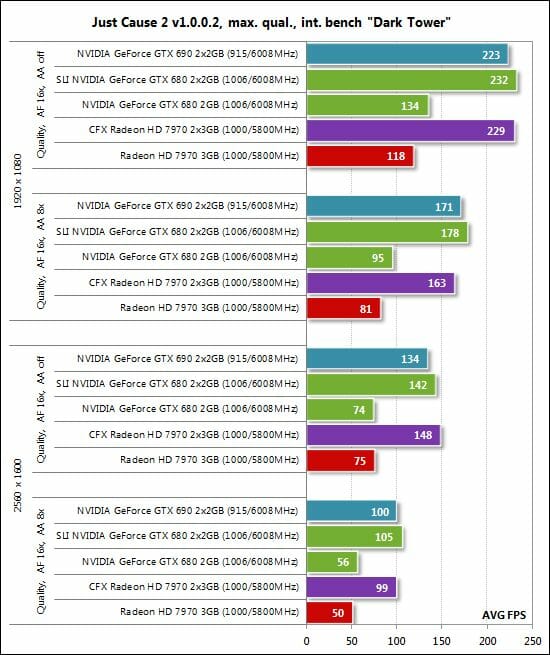
The three premium-class graphics solutions are comparable in Just Cause 2, yet the GeForce GTX 680s are just a little bit faster than the dual-chip GTX 690 and the Radeon HD 7970 CrossFireX.
Aliens vs. Predator (2010)
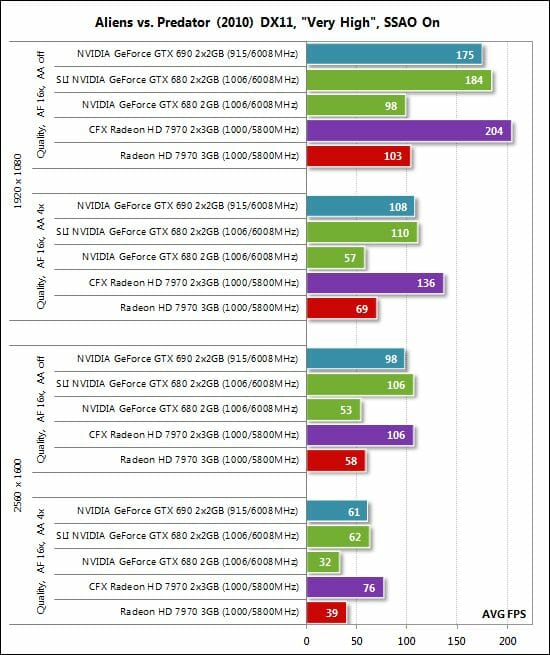
SLI can boast record-breaking efficiency in Aliens vs. Predator (2010), close to 100%, yet the GeForce GTX 680 SLI cannot beat the Radeon HD 7970 CrossFireX anyway.
Lost Planet 2
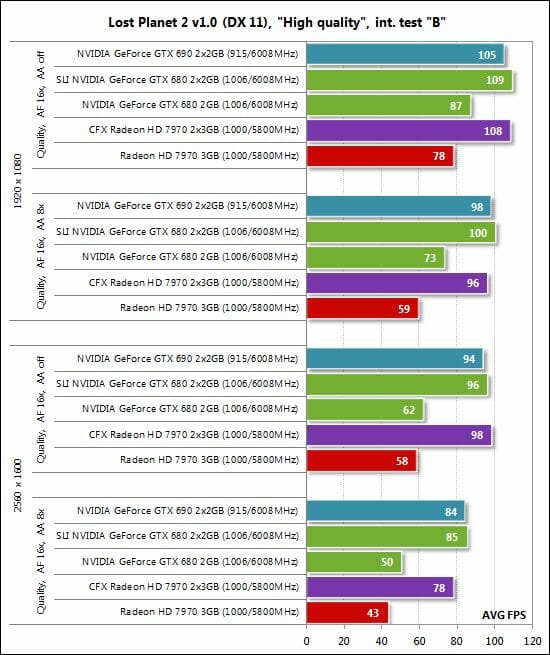
These results are similar to what we’ve just seen in Aliens vs. Predator (2010) except for the highest-quality settings. StarCraft II: Wings of Liberty
We have no surprises in this game:
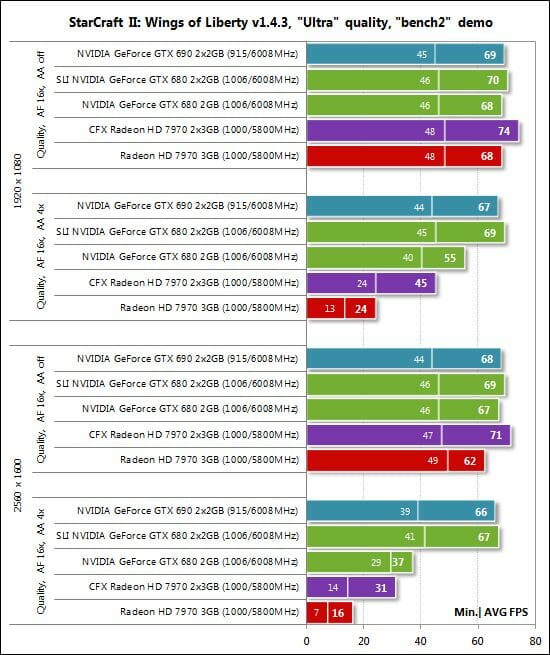
The efficiency of SLI can only be evaluated at the highest-quality settings.
Sid Meier’s Civilization V
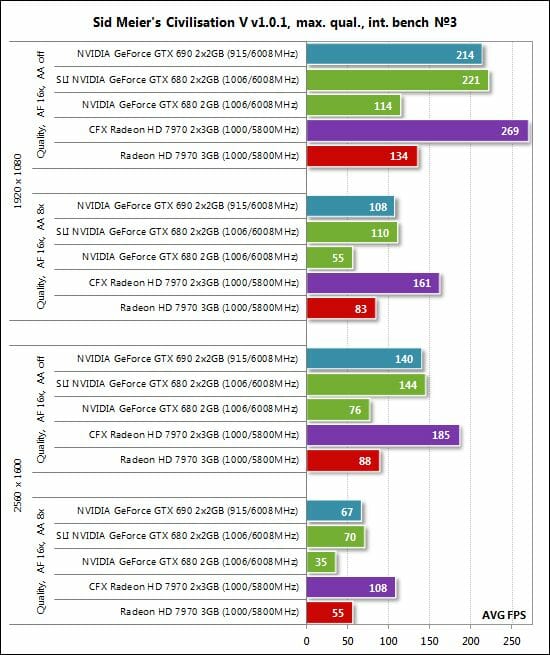
Nvidia’s multi-GPU technology works smoothly in Sid Meier’s Civilization V, too. The SLI tandem is up to 90% faster than the single card. The Radeon HD 7970s are even faster, though.
Tom Clancy’s H.A.W.X. 2
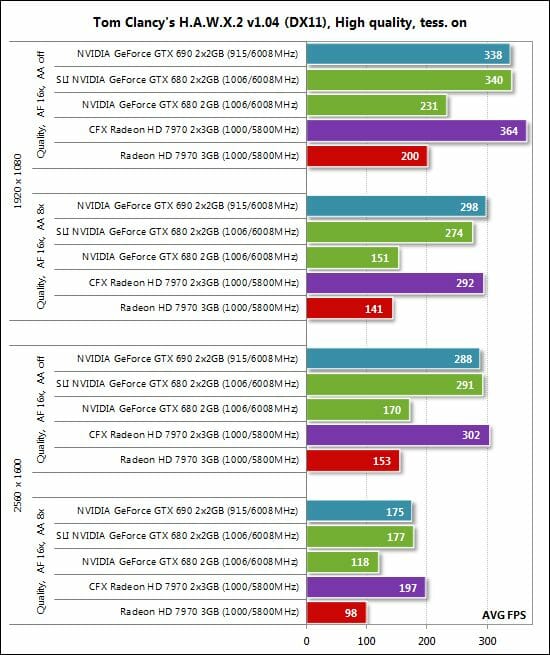
The CrossFireX configuration is superior in Tom Clancy’s H.A.W.X. as well, but the GeForce GTX 680 SLI is very fast, too.
Total War: Shogun 2
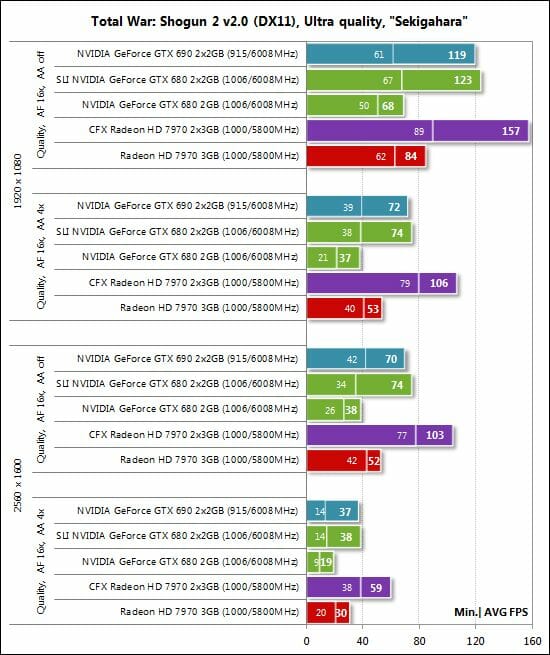
The two Radeon HD 7970s enjoy an even bigger advantage in Total War: Shogun 2, even though the SLI technology is highly efficient here.
Crysis 2
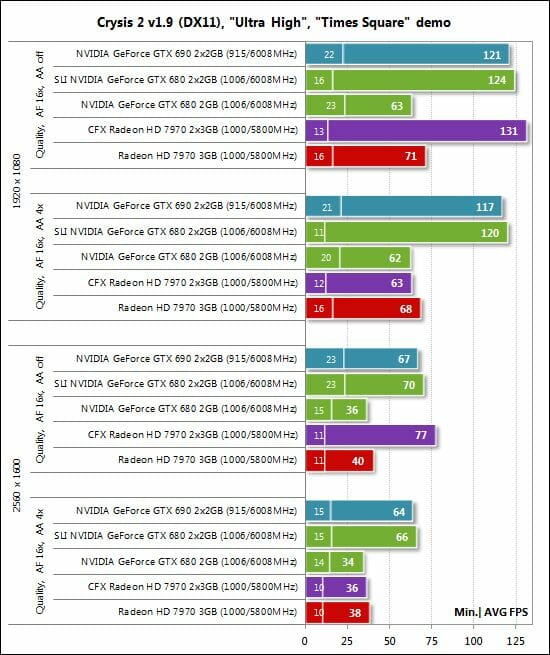
There are no surprises in Crysis 2 except that CrossFireX is incompatible with antialiasing. We wrote about this problem in our earlier review.
DiRT 3
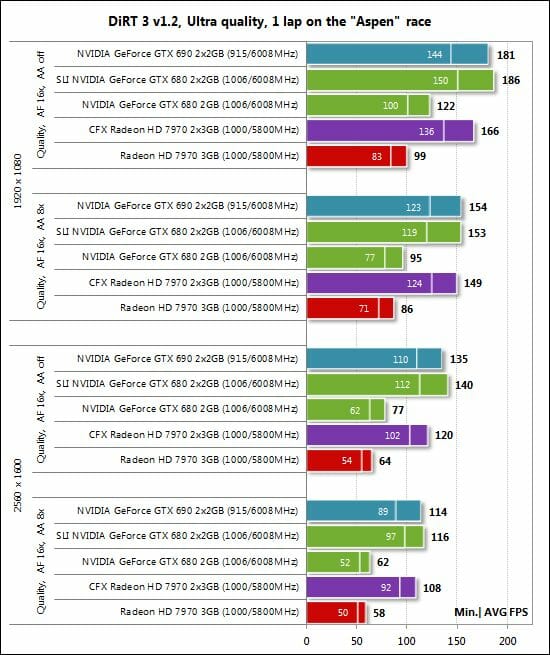
The multi-GPU solutions are all close to each other in DiRT 3, SLI being comparable to CrossFireX in efficiency.
Hard Reset Demo
We don’t see anything unexpected in Hard Reset and Batman: Arkham City:
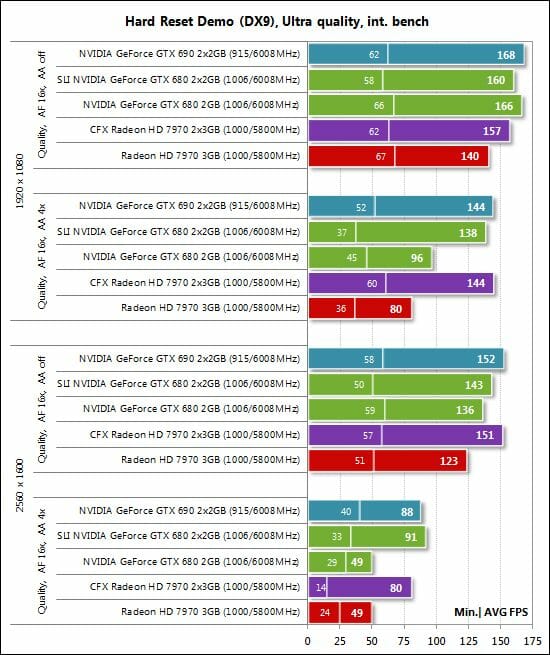
Batman: Arkham City
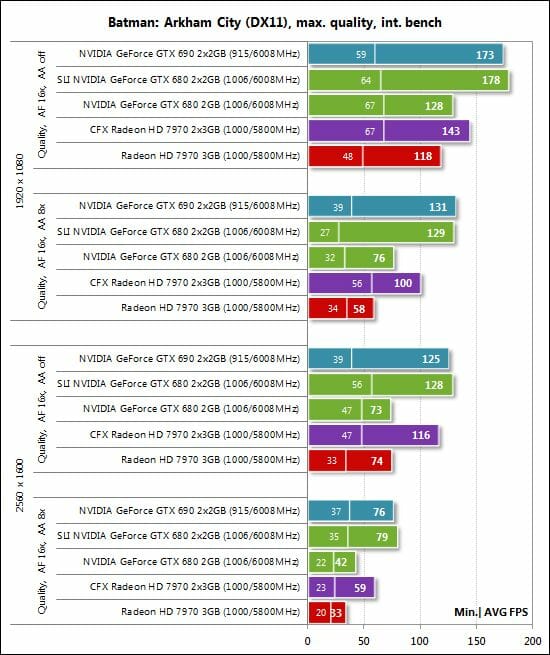
Battlefield 3
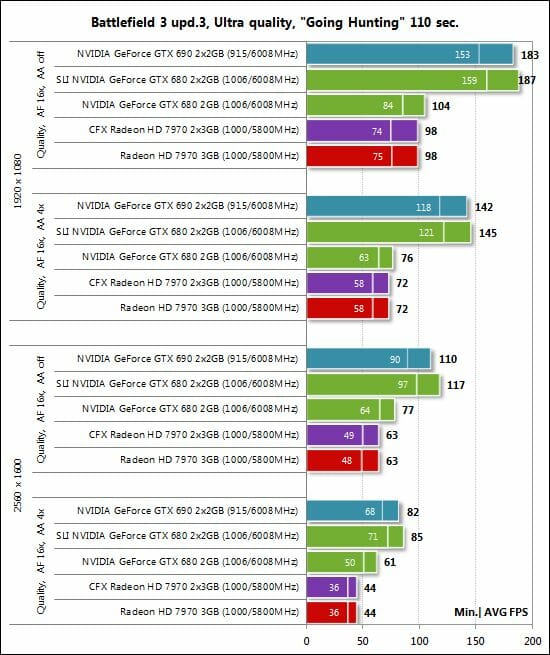
The SLI technology is highly efficient at 1920×1080 in Battlefield 3 but no more than 50% efficient at 2560×1600. Why? The dual-chip GeForce GTX 690 is far from brilliant, too. So, we can suspect that the performance of the GeForce GTX 680 SLI is limited by the amount of memory on board each card, which is 2 gigabytes. Or there may be some driver error that prevents the dual-GPU solutions from showing their best. Well, CrossFireX doesn’t work normally at all on the Radeon HD 7970s in this game, so Nvidia’s technology isn’t so bad after all.
Performance Summary
First let’s see how faster the SLI tandem of two GeForce GTX 680s is in comparison with one such card.
At 1920×1080 the GeForce GTX 680 SLI is an average 67% and 75% ahead of the single card with antialiasing off and on, respectively. The difference is larger at 2560×1600: 67% and 83%. And if we take only the most resource-consuming games that correctly support multi-GPU technologies, the SLI efficiency will be as high as 100%!
Now let’s compare the GeForce GTX 680 SLI with the GeForce GTX 690, the latter being a dual-GPU graphics card with two slightly down-clocked but full-featured GK104 Kepler chips.
The GeForce GTX 680 SLI is somewhat faster than the single GeForce GTX 690 in most of the tests, which might be expected considering their specs. The SLI tandem is an average 1.4 to 1.9% faster at 1920×1080 and 2.6 to 2.8% faster at 2560×1600. We should keep it in mind, however, that these numbers refer to average frame rates whereas the GeForce GTX 690 was often better in terms of the bottom frame rate.
The last pair of summary diagrams help us compare two multi-GPU solutions: GeForce GTX 680 SLI (2×2 GB, 1006/6008 MHz) and Radeon HD 7970 CrossFireX (2×3 GB, 1000/5800 MHz).
The Radeon HD 7970s are faster in Aliens vs. Predator (2010), Sid Meier’s Civilization V, Tom Clancy’s H.A.W.X. 2 and Total War: Shogun 2. In the rest of the games the two solutions are comparable or the GeForce GTX 680s win. Nvidia is an average 7-13% ahead of AMD at 1920×1080 and 3-18% at 2560×1600 across all the tests.
Power Consumption
We measured the power consumption of computer systems with different graphics cards using a multifunctional panel Zalman ZM-MFC3 which can report how much power a computer (the monitor not included) draws from a wall socket. There were two test modes: 2D (editing documents in Microsoft Word and web surfing) and 3D (the benchmark from Metro 2033: The Last Refuge at 2560×1600 with maximum settings).
We’ve included several graphics cards and GPU configurations into the table for the sake of comparison:
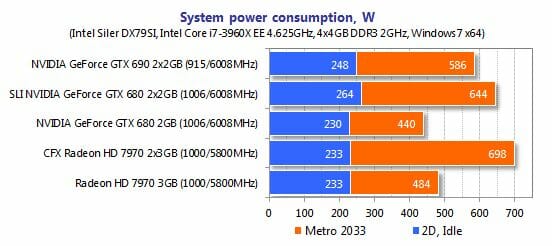
As expected, the system with two GeForce GTX 680s in SLI mode needs more power than the system with a single GeForce GTX 690 but is more economical than the configuration with two Radeon HD 7970s in CrossFireX mode. These are premium-class solutions, so they all need a high-wattage PSU with stable output voltages.
Conclusion
First of all, we’d like to say a few words about the Palit GeForce GTX 680 Jetstream 2GB. It is an interesting graphics card that can deliver the highest performance you can currently get with a single-GPU product. It is going to be stable thanks to its reinforced power system with high-quality components, so we even managed to overclock it a little above its already pre-overclocked frequencies.
The card features a highly efficient cooler. However, it is not much quieter than the reference GeForce GTX 680 cooler and even turned out to be louder in 2D mode. So, the card’s BIOS needs to be updated with optimal fan settings and, perhaps, the fans themselves should be replaced with quieter ones. The packaging of the product is robust and informative but its accessories are scanty. The 1-year warranty isn’t attractive compared to competitor products, either. Still, the Palit GeForce GTX 680 Jetstream is going to be a good choice, even as it already is, if you don’t mind the noise.
As for the SLI configuration we built out of two GeForce GTX 680s, it was only a little bit faster than the GeForce GTX 690. The difference can hardly be felt during actual play but the GTX 690 costs less, doesn’t require two full-speed PCI Express x16 slots, often delivers a higher bottom frame rate, consumes less power and is just quieter than the two GTX 680s. So, if you need the performance of two GeForce GTX 680s, we’d recommend you to consider buying a single GeForce GTX 690 instead.
We can also note that the SLI technology can boost the speed of the GeForce GTX 680 twofold in resource-consuming and SLI-optimized applications. And comparing the two multi-GPU technologies, the GeForce GTX 680 SLI was a little faster than the CrossFireX tandem of two slightly overclocked Radeon HD 7970s.